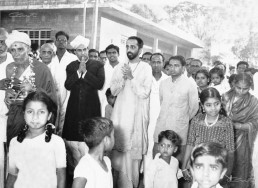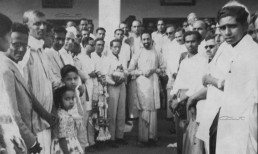
Jnana Yajna 37

Year & Dates:
February 09, 1958 to March 11, 1958

Yajna Topic:
Shrimad Bhagavad Gita- Chapters 5 & 6

Place:
Bengaluru, India.
It was the biggest pandal (tent) erected thus far in the open grounds of Malleshwaram, Bengaluru. Even so, by 6 pm on the evening of February 9, 1958, over 8000 people had occupied it. Given that the gathering was for Pujya Gurudev Swami Chinmayananda’s Gita Jnana Yajna, the overflowing audience had become a norm, not an exception. The 31-day yajna was inaugurated with grandeur and gusto by the Maharaja and Governor of Mysore, Sri Jayachamarajendra Wadiyar, and marked by an address by Maharaja Mohan Shamsher Jung Bahadur, the Rana of Nepal and patron of the Yajna Committee.
When Pujya Gurudev began His introductory talk chanting Om thrice with His inimitable voice, the pandal became a powerful Yajnashala. His voice stilled and thrilled the large gathering.
To Uplift and Give
To make man the master of life is the clarion call of Shrimad Bhagavad Gita. Pujya Gurudev stated that the noble idealism of the Gita must become an intrinsic part of life. Nourishing Bengaluru with both the milk and the cream – the Upanishad and its essence – Kenopanishad in the mornings and Gita chapters 5 & 6 in the evening sessions, Pujya Gurudev took the teeming audience to the peaks of Vedanta. He explained how renunciation can be gloriously incorporated in a path of detached action. His guidance on how to raise oneself through meditation inspired the audience; when Pujya Gurudev voiced the teachings of Bhagavan Krishna in chapters 5 & 6, He assured that renunciation and meditation could be practiced within the ambit of everyday life, slowly and surely.
The Akhanda Kirtan from February 27 to March 2, the three-day Gita Homa which concluded on March 2, and the memorable Avabhrta Snaana at the renowned Tirumala Temple Pushkarani (tank) on March 9 – in and through each aspect of the Jnana Yajna, Pujya Gurudev brought out the spiritual in the ritual.
Another outstanding and elevating part of all Jnana Yajnas that Pujya Gurudev conducted was the Guru Dakshina ceremony which became a hallmark of Chinmaya Mission. The ceremony of revering the Teacher who blesses disciples with the Abundance of Truth and Happiness is an ancient Vedic tradition. Pujya Gurudev needed nothing and gave everything. The Guru Dakshina ceremony was the devotees’ thanksgiving that upheld and supported not just Chinmaya Mission; often, the Guru Dakshina collected was shared in charity to serve many. And, as in other yajnas, every devotee was given a free copy of the Yajna Prasad. In the momentous 37th Jnana Yajna, the Guru’s blessing was “Hinduism at a Glance-Gita.” Pujya Gurudev instilled the practice of giving back even in the Guru Dakshina ceremony.
Photo Gallery

“Think,” Says Pujya Gurudev
Self-realization is not a melancholy parade crawling to a pre-destined tomb, but it is a joyous ride to the Palace of Truth, from which man had wandered away in his own ignorance and confusion. A true prophet-not an assumed one, laboriously keeping to himself the unnatural pose of an unrealized perfection-is one who lives himself consumed in an ever reviving fire of love. He ceaselessly strives to bring out “himself” from the rubbish that is veiling his own Self in all other forms around and about him. This is indicated by the term “engaged in the good of all-beings”.
This loka-seva becomes his recreation, his self-appointed engagement. His body, mind and intellect are offered as oblations into the sacred fires of activity and while remaining at rest with himself the Saint lives on in an unbroken Consciousness of the Divine, the Eternal.
From Bhagavad Gita- Chapter 6, Book
Thoughts appear in the mind at every second in a continuous stream, and these constant thought disturbances, each dying yielding place to a new one, gives us the apprehension of a solid factor called the mind. Similarly, the tip of a flame also, (it can be experimentally proved) is never steady, but the continuity of its change is so fast that it gives us an apparent illusion of solidarity.
When this flame is well protected from the fickle breeze, then it becomes steady in its upward flights. In the same fashion the flame of the mind, flickering at the whims and fancies for the passing sensuous desires, when arrested in a meditator, becomes steadily brilliant, although the mind is made to contemplate upon the Self by a constant flow of Brahmaakaara-vritti.
From Bhagavad Gita- Chapter 6, Book
Nobody can help Anybody!
Bhagavad Gita serves as a guidebook for navigating life’s trials, empowering individuals to find strength within themselves. Explore how to cultivate a mindset of equanimity and balance, enabling you to navigate through life’s ups and downs with grace and resilience.



